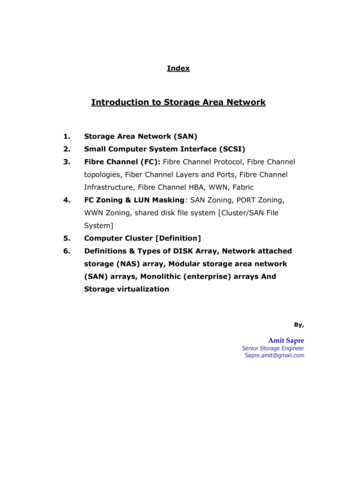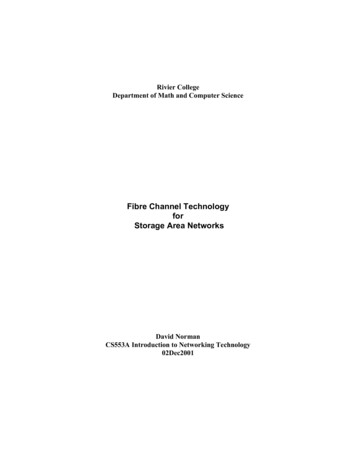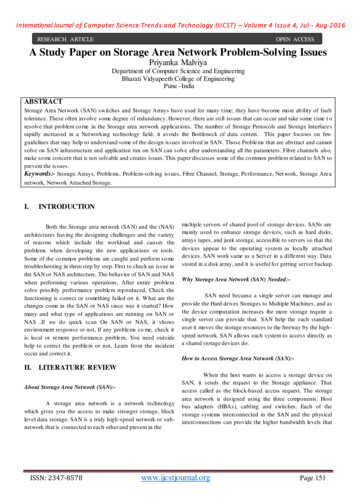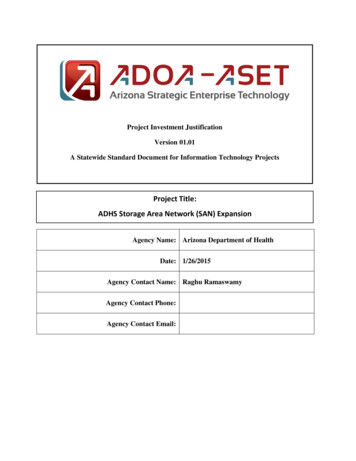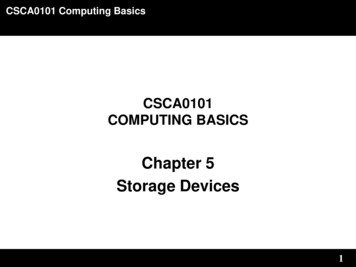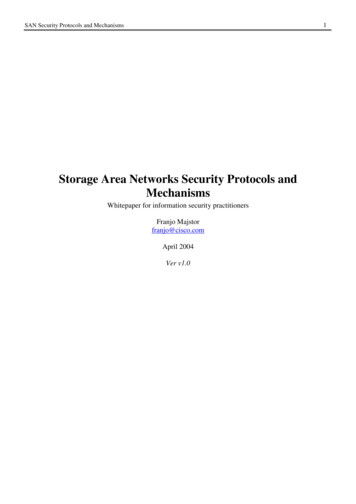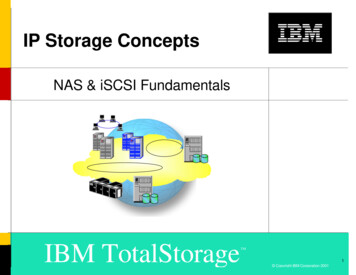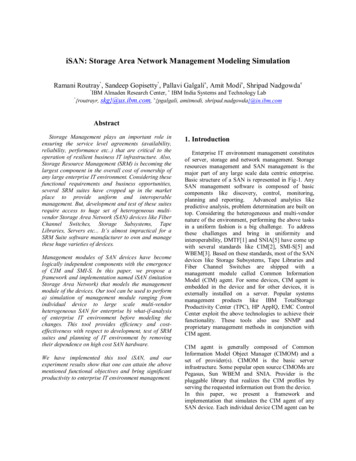
Transcription
iSAN: Storage Area Network Management Modeling SimulationRamani Routray*, Sandeep Gopisetty*, Pallavi Galgali , Amit Modi , Shripad Nadgowda IBM Almaden Research Center, IBM India Systems and Technology Lab{routrayr, skg}@us.ibm.com, {pgalgali, amitmodi, shripad.nadgowda}@in.ibm.com** AbstractStorage Management plays an important role inensuring the service level agreements (availability,reliability, performance etc.) that are critical to theoperation of resilient business IT infrastructure. Also,Storage Resource Management (SRM) is becoming thelargest component in the overall cost of ownership ofany large enterprise IT environment. Considering thesefunctional requirements and business opportunities,several SRM suites have cropped up in the marketplace to provide uniform and interoperablemanagement. But, development and test of these suitesrequire access to huge set of heterogeneous multivendor Storage Area Network (SAN) devices like FiberChannel Switches, Storage Subsystems, TapeLibraries, Servers etc. It’s almost impractical for aSRM Suite software manufacturer to own and managethese huge varieties of devices.Management modules of SAN devices have becomelogically independent components with the emergenceof CIM and SMI-S. In this paper, we propose aframework and implementation named iSAN (imitationStorage Area Network) that models the managementmodule of the devices. Our tool can be used to performa) simulation of management module ranging fromindividual device to large scale multi-vendorheterogeneous SAN for enterprise b) what-if-analysisof enterprise IT environment before modeling thechanges. This tool provides efficiency and costeffectiveness with respect to development, test of SRMsuites and planning of IT environment by removingtheir dependence on high cost SAN hardware.We have implemented this tool iSAN, and ourexperiment results show that one can attain the abovementioned functional objectives and bring significantproductivity to enterprise IT environment management.1. IntroductionEnterprise IT environment management constitutesof server, storage and network management. Storageresources management and SAN management is themajor part of any large scale data centric enterprise.Basic structure of a SAN is represented in Fig-1. AnySAN management software is composed of basiccomponents like discovery, control, monitoring,planning and reporting. Advanced analytics likepredictive analysis, problem determination are built ontop. Considering the heterogeneous and multi-vendornature of the environment, performing the above tasksin a uniform fashion is a big challenge. To addressthese challenges and bring in uniformity andinteroperability, DMTF[1] and SNIA[5] have come upwith several standards like CIM[2], SMI-S[5] andWBEM[3]. Based on these standards, most of the SANdevices like Storage Subsystems, Tape Libraries andFiber Channel Switches are shipped with amanagement module called Common InformationModel (CIM) agent. For some devices, CIM agent isembedded in the device and for other devices, it isexternally installed on a server. Popular systemsmanagement products like IBM TotalStorageProductivity Center (TPC), HP AppIQ, EMC ControlCenter exploit the above technologies to achieve theirfunctionality. These tools also use SNMP andproprietary management methods in conjunction withCIM agent.CIM agent is generally composed of CommonInformation Model Object Manager (CIMOM) and aset of provider(s). CIMOM is the basic serverinfrastructure. Some popular open source CIMOMs arePegasus, Sun WBEM and SNIA. Provider is thepluggable library that realizes the CIM profiles byserving the requested information out from the device.In this paper, we present a framework andimplementation that simulates the CIM agent of anySAN device. Each individual device CIM agent can be
simulated in this framework based on the specificationdefined in a XML file. Based on user suppliedspecification, we can simulate multiple CIM agentsthat combined together represent a SAN. In this case,information exposed by simulated CIM agents need tobe correlated to one another to virtually represent aSAN from management modeling perspective. We usedatabase for storing device configuration details, astandard set of providers and a service for generatingand correlating data across CIM agents. Modeling andimplementation of profiles like fabric profile, arrayprofile, server profile etc in correlated and temporalfashion provides a completely virtual SAN.SRM vendors spend huge amount of money in settingup heterogeneous environment to develop and test theirsoftware or access geographically distributedheterogeneous environments over network. SNIA alsohosts such a lab for interoperability and certificationtesting.Administrators also do not have access to any standardprimitives that can help them perform impact analysisbefore they deploy new hardware or perform certainconfiguration change operation on their SAN.By simulating CIM agents of multiple SAN devices ina collective fashion, virtual SAN can be exposed to aSRM suite. SRM suites can use iSAN for the followingpurposes: Visual workbench to drag and drop differentdevices and connect them together to get a virtualSAN from management perspective.SRM suite can perform regular managementfunctions like discovery, configuration andmonitoring on the virtual SAN as if it is a realSAN.Planning of a SAN from scratch or extension of anexisting SAN in a virtual environment to performwhat-if-analysis.Impact analysis against fault injection or growthpattern in a temporal fashion.Minimize network latency by presenting a virtualSAN close to the management server.Snapshot any real live CIM agent and replay itusing iSAN’s record-replay mechanism.It is important to note that the virtual SAN with theabove features brings in significant value add to themanagement suite because these tools never reallyrequire the existence of a real heterogeneous SAN forit’s development and testing.Fig. 1. Representation of a storage area network where servers(such as file and print servers, email servers and databaseservers) access data storage in subsystems and tape libraries viahost bus adapters over a switched network.The rest of the paper is organized as follows: Section 2describes the system architecture overview of iSAN.Section 3 describes experimental evaluation,evaluation strategy and results. We present related andfuture work in Section 4 and conclude in Section 5.2. System OverviewThis section provides an overview of iSAN. Itdiscusses the input, output and key components of thistool in following subsections. Architecture andcomponents of iSAN is shown in Figure-2. Words like“user” and “administrator” have been usedinterchangeably and mean the user of iSAN.iSAN obtains input about the required SANenvironment through a visual workbench and generatesa set of correlated CIM agent(s). iSAN’s generation ofvirtual SAN environment is classified into thefollowing two broad categories:Snapshot Approach: Using this approach, user cantake snapshot of a set of device CIM agent(s) thatrepresent a real live SAN. Snapshot image is thenreplayed through iSAN.
to determine. User specification from graphicaldescription is converted into a XML document. ThisXML document depicts the devices, deviceconfigurations and their connectivity. SAN plannersthat take declarative requirement specifications andgenerate the SAN blueprint can also be plugged intothe visual workbench. Once, an operational iSANenvironment is established, it can be visually tweakedfor what-if-analysis.2.2 Snapshot MakerFig. 2 : Architecture of iSANThis approach helps minimize the network latency (e.g.users accessing SNIA lab over WAN can run the exactsame set of device CIM agents from their local LAN).Also, users can extend the snapshot through the visualworkbench and perform what-if-analysis. In thisapproach, data from one or more CIM agent isretrieved by traversing the profiles. All the retrievedinformation is persisted in iSAN device configurationrepository. Managed Object Format (MOF) filesdescribing CIM class definitions are also queried fromreal live CIM agents and compiled into the iSANsimulated CIM agents.Configuration Approach: Using this approach, usercan specify the configuration of the required SANenvironment. iSAN generates the required data andhosts the CIM agent(s) that represents the virtual SANenvironment. Data generation in this approach isgoverned by device templates. Templates are nothingbut canned definitions of CIM implementations anddefinitions for a given device from a particularmanufacturer.Following subsections describe individual componentsof iSAN in detail.2.1 Visual WorkbenchVisual workbench is a visual editor where user canspecify the input for iSAN and visualize the generatedvirtual SAN. For snapshot approach, user specifiesinformation about the real live CIM agent(s). Forconfiguration approach, user drags and drops SANdevices into the visual workbench and establishesconnectivity. Also, certain level of randomconnectivity among devices can also be left for iSANSnapshot Maker takes the snapshot of any live CIMagent. Live device CIM agent is basically a collectionof CIM instances that realizes a collection of profiles.CIM instance is instance of a CIM class. Definition ofCIM classes, supported profiles etc. are also exposedby CIM agent in a standard fashion. Based on theseCIM agent definitions, snapshot maker scans thenamespace(s). For each of the namespace, CIMinstance(s) of all of the CIM classes are retrieved fromthe CIM agent by performing enumerateInstances APIinvocation. This invocation is performed by the CIMclient that is embedded inside iSAN. Namespaces,CIM class names, enumerated CIM instances alongwith CIM objectpath(s) are cleansed, indexed andpersisted in the device configuration repository. Thiscomponent follows a very standard cookie-cutterapproach that can snapshot any CIM agent.Enumeration of CIM instances are done with allexpanded options:enumerateInstances (CIMObjectpath OP with className and namespace,boolean deep true,boolean localOnly false,boolean includeQualifiers true,boolean includeClassOrigin true,String[] propertyList null );Cleansing of the retrieved involves formatting of thedata with respect to the delivering CIMOM. Indexingof the information helps in replaying back the persistedinformation efficiently through iSAN provider.Definition of CIM classes that are represented in aMOF (Managed Object Format) is also compiled intothe iSAN CIMOM from the real live CIMOM. Detailsof MOF Scanner, Provider are described in subsequentsections.But, this approach described so far assumes exclusiveaccess of snapshot maker to the real CIM agent.Because, real live CIM agent can be reflecting thechanging configurations that might not be consistentacross start time and end time of the snapshot process.So, to capture a consistent device configuration from
the real CIM agent, device is left untouched during thesnapshot process. This process of snapshot making iscalled offline snapshot.In certain scenarios, access to real live CIMOM accesscan not be restricted only to iSAN snapshot makerduring the snapshot process. So, to solve this problem,at the beginning of the online snapshot process, iSANsubscribes to CIM indications of all the instancecreation, deletion and modifications. In the due courseof CIM instances being copied by snapshot maker, ifany instances are modified, iSAN copies the old datafirst to the device configuration repository before theinstance gets modified in the real live CIM agent. CIMinstances that get created after the beginning of thesnapshot process do not get copied by the snapshotmaker. CIM instances that are deleted after thebeginning and before the end of the snapshot processget copied by the snapshot maker. Snapshot createdusing this process is called point-in-time snapshot. But,this approach is restricted by limitations of certaindevice CIM agents that are being snapshotted.Creation of snapshot of CIM agents reduce networklatency of SRM testing frameworks significantly bypresenting a virtual SAN in a local LAN. Also, thisapproach removes the constraint of SRM developmentand testing on SAN availability.2.3 MOF ScannerSnapshot maker persists the CIM instances from thelive CIM agent. But, the CIM class definitions fromreal live CIMOM represented in Managed ObjectFormat (MOF) needs also to be copied for compilationinto the iSAN CIMOM. During the snapshot process,CIM class definitions are also copied by MOF scannerand compiled into the iSAN CIMOM. iSAN alsoexposes a support matrix describing the device types,manufacturer and CIM agent versions that aresupported. iSAN scans MOF files of the multi-vendordevices for each CIM agent version from real live CIMagents and stores them in it’s knowledge repository.MOF scanning involves retrieval of class definitions,class hierarchy, methods and qualifiers by use of CIMcalls like enumerateClasses.2.4 Template GeneratoriSAN supports several types of devices to be draggedand dropped and interconnected in the visualworkbench. Each device manufacturer exposes deviceinformation in compliance with CIM. But, vendorspecific naming convention and internal devicecomponent arrangement are still proprietary. To beexact and close to the real devices, iSAN scans throughthe CIM instances of real live CIM agent and builds atemplate. These templates for different deice types arestored in the knowledge repository of iSAN. Eachtemplate is uniquely identified by a tuple: e.g. template(device Storage Subsystem, type model-2107,manufacturer IBM, CIM Agent Version 5.0).Templates capture i) naming conventions ii) profilessupported iii) modeling and extension used by vendorsfor CIM entities – number of instances, associations iv)device control flow for configuration change action.Generation of template is a continuous process. Thisprocess is similar to the process of automaticallygenerating DTD /XML schema from a given XMLdocument. Schema becomes more concrete and correctwhen it encounters a large variety of XML documentsthat conforms to the schema. Template generator isvalidated against CIM data of devices of same type andCIM agent version with a variety and range ofconfigurations. Template can also be generatedmanually by discussing the structure of devices ally gets verified by device manufacturesbefore being certified for use. Sample portion of atemplate for class IBMTSESS StorageSystem of IBMDS8000 Storage Subsystem CIM agent version 5.1.1 isshown below: Class Name "IBMTSESS StorageSystem"Namespace "/root/ibm"NOI ""CfgExp "[NUMBER OF STORAGE SYSTEM]" Property Name "cache" Type "string"Random "false" Value /Value /Property Property Name "Caption" Type "string"Random "false" Value IBM TotalStorage DS8000 /Value /Property Property Name "codelevel" Type "string"Random "false" Value 5.2.0.917 /Value /Property Property Name "CreationClassName"Type "string" Random "false"Key "true" Value IBMTSESS StorageSystem /Value /Property Property Name "Dedicated" Type "uint16[]"Random "false" Value 3,15 /Value /Property . /Class
In the example given above, CfgExp is a pointer to theconfiguration parameters specified by the user.Template for the class IBMTSESS DiskDrive givenbelow captures the naming conventions: Class Name "IBMTSESS DiskDrive"Namespace "/root/ibm"NOI ""CfgExp "[NUMBER OF EXTENTS]"AutoGenerate "false" Property Name "DeviceID" Type "string"Random "true" Key "true"Multiple "true" Value 6 /Value Value 6 /Value /Property Property Name "Name" Type "string"Random "false" Refers "DeviceID"Prefix "Disk Drive " /Property Property Name "InstanceID" Type "string"Random "false" Key "true"Refers "true" Multiple "true" Value External "IBMTSESS StorageSystem"Prefix "" Suffix "-" Name /Value Value Prefix "" Suffix "" DeviceID /Value /Property Property Name "TargetAddress" Type "string"Random "true" Prefix "" Suffix ""Separator "." Multiple "true" Value 3 /Value Value 3 /Value Value 3 /Value Value 3 /Value /Property /Class 2.5 Data GeneratorAs described in sub sections 2.3 and 2.4, MOFdefinitions of classes and template describing themodeling structure of devices are available inknowledge repository. Based on these availablecapabilities, user is allowed to drag and drop devicesinto the visual workbench to construct a SAN. Once,the specification of SAN is obtained as user inputthrough the workbench, data needs to be generated tosupport the device configurations. This componentdeals with generation of data based on SANconfiguration specification. User specifies low levelspecifications for each device connected in the SANalong with the device connectivity. Consider anexample scenario, where the user connects two serversto a fabric that contains four fiber channel switches andone storage subsystem. This basic SAN with a nosingle-point-of-failure connectivity of server to storageis depicted in Figure-3.Detailed configuration about each individual entity canalso be specified through the visual workbench.Connectivity with device configuration created throughthe visual workbench generates a XML document.Detailed information in this regard is explained inSection 3.Fig. 3: Sample SAN with no single point of failure connectivityFiber channel port connectivity between SAN devicescan be done using one of the following approaches: i)user explicitly specifies the connectivity between portsby using the visual workbench primitives ii) user canopt for a random connectivity decided by iSAN iii)output of planners can be integrated with iSAN e.g.SRM planners provides connectivity template for nosingle-point-of-failure.Based on the user input, iSAN picks the appropriatetemplate from the knowledge base and generates theCIM data required to represent the deviceconfigurations. It is important to note that generateddata for different CIM agents need to be correlated torepresent the SAN in a cohesive fashion. For example,ProtocolEnpoint along with ActiveConnectioninformation from FC switch CIM agent needs to becorrelated with server and storage subsystem. LUNinformation from server must be correlated withVolume information from storage subsystem. Zoneconfiguration information of fabric must be correlatedwith server and storage ports.CIM instances generated by data generator componentis persisted in a persistent data store called deviceconfiguration repository. Generated data could bepersisted in one or multiple repositories. At this point,CIM agent becomes operational based on the suppliedspecification. But, data generator also continuouslymodifies the data in the repositories due to the controloperations (e.g. creation of volume in a ume, modification of attributes ofStoragePool, indication about the creation of toragePool etc ). Also, for support ofBlock Server Performance (BSP) profile and switchprofile, data generator continually populates the
repositories with requiredbackground daemon thread.informationusingaGenerated data is served back to consumers like SRMsoftware through providers.2.6 Device Configuration RepositoryCIM information collected using snapshot approach orgenerated CIM information using configurationapproach is persisted in one or multiple deviceconfiguration repositories. This repository can be asimply a set of files or can be a relational database.CIM instances stored in repository can be i) serializedobjects on files ii) instance shredded into propertiesand values in file/database iii) BLOBs in database. Wehave used database as repository and stored CIMinstances as BLOBs due to scalability and performancereasons. At a very high level, repository containsfollowing four categories of information linkedtogether: Information about the connectivity and credentialsof the CIM agent.Information about the namespace(s) associatedwith the CIM agent.Information about CIM classes associated with thenamespace.Information about the CIM data (CIM objectpath,CIM instance) associated with the CIM classes.2.7 ProviderCIM providers are the pluggable modules that getplugged into the CIMOM for device operations. iSANcontains a set of providers to serve data out of therepository based on the types of open source CIMOMs.Due to the relational nature of the repository, CIMproviders of iSAN also match to SQL queries. iSANimplements instance provider, association provider,method provider and indication provider.2.8 Knowledge RepositoryKnowledge Repository is a set of MOF files andtemplates stored persistently for use of iSAN. Based onthe contained data in the repository, visual workbenchexposes a support matrix of supported devices that canbe used for construction of virtual SAN. A device ofany given type is manufactured by multiple vendors.Vendors release device CIM agents very frequently tobe in line with the fast changing CIM specificationsand device capabilities. So, MOF files are stored foreach device manufactured by certain vendor for agiven release.3. Experimental EvaluationThis section describes our experimental evaluationscriteria. We have focused much on the correlation ofdifferent types of CIM agents that combined togetherrepresent a heterogeneous SAN. Our current types ofdevice simulation include Server, Host Bus Adapter,Fiber Channel Switch, Storage Subsystem and TapeLibrary. For each of these devices, we compiledtemplates for multiple versions from multiple vendors.Here is a list of all the profiles that are supported :We would like to state that performance comparisonand CIMOM scalability are not part of our evaluation.This is because, we used available open sourceCIMOMs[17, 18]. For large scale configuration ofdevice or for large number devices, we have useddatabase as the backend data store. Providers alsomatch out to SQL queries, since data store is adatabase. So, scalability of data store or provider is nota concern in iSAN model. Scalability and performancestudies[14] of open source CIMOMs have been done inthe past.For snapshot approach, we have taken snapshot of amedium scale SAN that is used by our facility. ThisSAN contains three IBM DS4300, two IBM DS6000,one IBM DS8000, four Brocade Silkworm fiberchannel switches, two QLogic fiber channel switches,two McData fiber channel switches and 27 servers.Thirty five CIM agents manage the SAN describedabove containing 41 devices. iSAN performed aparallel snapshot operation of these 34 CIM agents andstored the information in eight database instances.Three servers were used by iSAN to simulate andreplay the 34 CIM agents. Time taken by iSANsnapshot routine to snapshot a live CIM agent variesbased on the size on the configuration of the devicesthat dictates the number of CIM instances.Without any reference to network latency and latencyof the device for data generation, Fig-4 showsscalability of time taken to snapshot devices fornumber of instances. Using the configuration approach,we tried to simulate the above SAN with an addition oftwo tape libraries. Configuration of each device thatwas specified using the visual workbench capturedinformation of following nature:Server [Type eSeries Model 1849
Processor Intel XeonSoftware MS Office, WASManufacturer IBMOS Windows 2003HBA [Type QLA2460 Model CKManufacturer QLogicPort 2]]Fabric [ZoneConfig [ZoneSet compositionZone compositionZoneMember composition ]FC Switch [Type 4100 Model SilkwormManufacturer BrocadePort 8 NUM 4]]StorageSubsystem [Type 800 Model 2107Manufacturer IBMStorageExtents compositionStoragePools extent compositionStorageVolumes compositionMaskingMapping composition]Fig. 4: Time taken to snapshot Device CIM AgentsConnectivity [visually wired / random / planner]Fig. 5: Effect of iSAN indexing on Association providersData generators generated data for the 43 devices andhosted the simulated iSAN CIM agents on four servers.For Block Server Performance profile and switch portstatistics, iSAN updates the device repositories on aperiodic basis.Control functions were also implemented in iSANproviders. Examples of some of the control functionsare: creation/deletion of Volumes and Pools on astorage subsystem, creation of Zone, ZoneSet,addition/removal of Zone to ZoneSet or ZoneMemberto Zone etc. Indication generation was also integrated.Information like ProtocolEndpoint, LUN etc exposed by the server, switch and storage subsystemCIM agents were in sync with one another.In addition to the CIM defined indexes, iSAN indexingcontributed to a faster association and referenceprovider with an additional one time cost of generatingthe indexes during snapshot. A comparative analysis isdescribed in Fig- 5.Based on the generated data, we ran the analytic toolsoffered by TPC to check for any best practiceviolation. System administrators can take snapshot oftheir existing environment and then extend it usingiSAN to the planned environment. High level analyticslike configuration analysis can then be performed onthe projected environment. Visual workbench allowsthis mode of what-if-analysis. Otherwise, users canprovide the configuration of their projectedenvironment to iSAN to generate what-if-analysis.4. Related WorkSimulation of networked storage and its componentshas been tried out at various levels.Most of these simulations fall in the category ofstorage subsystem simulation. Disk system simulatorDiskSim [6] helps understand modern storagesubsystem performance and how storage performancerelates to overall system performance and to evaluatenew storage subsystem architectures. Pantheon [7] isanother storage system simulator that supportsmodeling of wide range of I/O systems for bothuniprocessor and parallel computers. IBM Object
Storage Device (OSD) simulator [8] enables thecreation of self-managed, shared, and secure storagefor storage networks. All these above simulatorssimulate the core storage subsystem.iSAN. Finally, this tool can be integrated with coredevice simulators for complete device simulation.IBM SMI-S based storage device simulator [9] is animplementation using CIM and SMI-S which mainlysimulates IBM storage subsystems DS6000 andDS8000. This approach uses create/setInstancesprimitives to populate device repository based on userspecification. But, this simulation does not providecorrelated multi-device simulation for a wholenetworked storage environment setup.[1] Distributed Management Task Force (DMTF)[2] Common Information Model (CIM)[3] Web Based Enterprise Management (WBEM)[4] Managed Object Format (MOF)[5] Storage Networking Industry Association (SNIA)SANBlaze [10] has attempted emulation of storagedevices (disk drive, tape drive or arrays) bymanufacturing target and initiator emulators for FiberChannel, SAS and other storage protocols. Networkmodeling has been tried using SNMP basedsimulations. One of the examples of SNMP basednetwork simulations is Adventnet’s simulation toolkit[11]. Netsim [12] is a customizable simulator for highperformance point-to-point workstation networks. Itcan be used for application level performance analysis.SANSim [13] provides simulation of FC SAN. Itapproaches simulation using event driven methodologyby implementing various modules for workload,server, network, storage system etc.Simulation of core entities like disk subsystems,network switches [6, 7, 12, 13] can be combined withour management module simulation for a completedevice simulation. Planning or modeling tools[19, 20,22] can be integrated with the visual workbench totransform declarative user input to required SANblueprint. SNMP [11] and any other vendor specificmanagement modules can be plugged into iSAN.Analytical models [15, 16, 21] can then be built intothese complete device simulators for performancebottleneck analysis, application impact analysis, faultinjection and analysis.5. ConclusionIn this paper, we propose a simulation framework forstorageareanetworkmanagement.Thisimplementation can be used in one of the two ways(snapshot , configuration) to replicate any devicemanagement module called CIM agent. Thisframework removes the dependency of costly SANhardware from Storage Resource Management suites.Development, test tool of SRM suites, what-if-analysistask of administrators are the key contributions of6. References[6] DiskSim Simulation Environmenthttp://www.pdl.cmu.edu/DiskSim/[7] HP Pantheon storage system simulator[8] IBM Object Storage Device m[9] IBM SMI-S-Based Storage Device Simulatorhttp://www.alphaworks.ibm.com/tech/smis simulator[10] Sanblaze - www.sanblaze.com[11] Adventnet SNMP based network simulation[12] M. Uysal et al., "A Customizable Simulator forWorkstation Networks", Proceedings of theInternational Parallel Processing Symposium, April1997.[13] Chao-Yang Wang et al., Simulation of FibreChannel Storage Area Network Using SANSim”,Proceedings of 11th IEEE International ICON2003[14] Sun-Mi Yoo et al., “ Performance Evaluations ofWBEM Implementations ”[15] Wang, Y. et al., "Execution-driven simulation ofnetwork storage systems", proceedings of Modeling,Analysis, and Simulation of Computer andTelecommunications Systems, 2004. (MASCOTS2004)[16] LI Chao et al., "Using MMQ Model forPerformance Simulation of Storage Area Network",proceedings of 21st International Conference on DataEngineering Workshops (ICDEW'05)[17] Open Pegassus Project[18] Sun WBEM Implementation[19] Molero, X. et al., "A tool for the design andevaluation of fibre channel storage areanetworks",proceedings of 34th Annual Simulation Symposium,2001[20] Anderson E. et al, "Quickly finding near-optimalstorage designs"[21] Anderson, E. et al., Ergastulum: An approach tosolving the workload and device configurationproblem.[22] Julie W. et al., "Appia: automatic storage areanetwork fabric design", proceedings of USENIX FAST2002
Fig. 1. Representation of a storage area network where servers (such as file and print servers, email servers and database servers) access data storage in subsystems and tape libraries via host bus adapters over a switched network. The rest of the paper is organized as follows: Section 2 describes the system architecture overview of iSAN.
